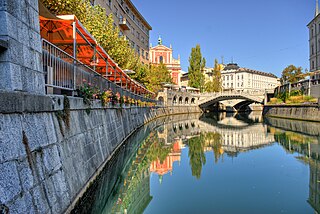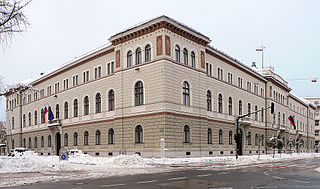Related Research Articles

The Brazilian Armed Forces are the unified military forces of the Federative Republic of Brazil. Consisting of three service branches, it comprises the Brazilian Army, the Brazilian Navy and the Brazilian Air Force.

The Slovenian Armed Forces or Slovenian Army are the armed forces of Slovenia. Since 2003, it is organized as a fully professional standing army. The Commander-in-Chief of the SAF is the President of the Republic of Slovenia, while operational command is in the domain of the Chief of the General Staff of the Slovenian Armed Forces.

Ljubljana is the capital and largest city of Slovenia, located along a trade route between the northern Adriatic Sea and the Danube region, north of the country's largest marsh, inhabited since prehistoric times. It is the country's cultural, educational, economic, political and administrative center.

The Yugoslav People's Army, also called the Yugoslav National Army, was the military of the Socialist Federal Republic of Yugoslavia and its antecedents from 1945 to 1992.

Ivan Cankar was a Slovene writer, playwright, essayist, poet, and political activist. Together with Oton Župančič, Dragotin Kette, and Josip Murn, he is considered as the beginner of modernism in Slovene literature. He is regarded as the greatest writer in Slovene, and has sometimes been compared to Franz Kafka and James Joyce.

The Ljubljanica, known in the Middle Ages as the Leybach, is a river in the southern part of the Ljubljana Basin in Slovenia. The capital of Slovenia, Ljubljana, lies on the river. The Ljubljanica rises south of the town of Vrhnika and flows into the Sava River about 10 kilometres (6.2 mi) downstream from Ljubljana. Its largest affluent is the Mali Graben Canal. Including its source affluent the Little Ljubljanica, the river is 41 km (25 mi) in length. The Little Ljubljanica joins the Big Ljubljanica after 1,300 m (4,300 ft) and the river continues its course as the Ljubljanica.

Vrhnika is a town in Slovenia. It is the seat of the Municipality of Vrhnika. It is located on the Ljubljanica River, 21 km from Ljubljana along the A1 motorway.

The Ten-Day War, or the Slovenian War of Independence, was a brief armed conflict that followed Slovenia's declaration of independence from Yugoslavia on 25 June 1991. It was fought between the Slovenian Territorial Defence together with Slovene Police and the Yugoslav People's Army. It lasted from 27 June 1991 until 7 July 1991, when the Brioni Accords were signed.

Prešeren Day, full name Prešeren Day, the Slovene Cultural Holiday, is a public holiday celebrated in Slovenia on 8 February. It is marking the anniversary of the death of the Slovene national poet France Prešeren on 8 February 1849 and is the celebration of the Slovenian culture. It was established in 1945 to raise the cultural consciousness and the self-confidence of the Slovene nation, and declared a work-free day in 1991. On 7 February, the eve of the holiday, the Prešeren Awards and the Prešeren Fund Awards, the highest Slovenian recognitions for cultural achievements, are conferred. Prešeren Day continues to be one of the most widely celebrated Slovene holidays. During the holiday all state and municipal museums and galleries offer free entry, and various other cultural events are held. The holiday is celebrated not only in Slovenia, but also by Slovene communities all around the world.

The Battle of Dražgoše was a Second World War battle between the Slovene Partisans and Nazi Germany armed forces, which took place between January 9 and January 11, 1942, in the village of Dražgoše in German-annexed Slovenia. This battle was the first direct confrontation between the two. It ended with brutal reprisals of German forces against the villagers and the destruction of the village.

Metelkova is an autonomous social and cultural centre in the city centre of Ljubljana, Slovenia's capital city. Formerly, the site was the military headquarters of the Army of the Austro-Hungarian Empire, then it became the Slovenian headquarters of the Yugoslav People's Army. It consists of seven buildings extended over a total area of 12,500 m2, which have been squatted since September 1993. The squat is named after nearby Metelko Street, which is named after the 19th-century Slovenian Roman Catholic priest, philologist, and unsuccessful language reformer Fran Metelko.

St. Peter's Bridge, also Ambrož Bridge, is a bridge in Ljubljana, the capital of Slovenia, that crosses the river Ljubljanica in the northeastern end of the old town. It is a continuation of Rozman Street. West of it lie Vraz Square on the northern (left) bank of the river and Ambrož Square on its southern (right) bank. East of it lies the Petkovšek Embankment on the northern bank and the Poljane Embankment on the southern bank. The bridge is named after the nearby St. Peter's Church. It is intended primarily for motorised traffic, but is also used by pedestrians.
The Ivan Cankar District is a city district of the City Municipality of Maribor in northeastern Slovenia. It is named after Ivan Cankar, one of Slovenia's greatest writers. In 2014, the district had a population of 7,242.

The Cankar Centre or Cankar Hall is the largest Slovenian convention, congress and culture center. The building was designed by the architect Edvard Ravnikar and was built at the southern edge of Republic Square in Ljubljana between 1977 and 1982. Construction was funded entirely by the Socialist Republic of Slovenia.

Slovenian Air Force and Air Defence is a part of the Slovenian Armed Forces. It is an integral part of the command structure, not an independent branch.

Mirna is a nucleated village and a minor economic centre in central Lower Carniola, Slovenia. It is the largest settlement of the Mirna Valley and the seat of the Municipality of Mirna. It is situated at the crossing of regional roads and a confluence of several creeks with the Mirna River, along the railway line linking Sevnica and Trebnje.

The Government Building and President's Office, also simply the Government Building or the President's Office, is a building in Ljubljana, the capital of Slovenia, that houses the Office of the President of Slovenia, the Secretary-General of the Government of Slovenia, and the Protocol of Slovenia. It stands at the corner of Prešeren Street, Erjavec Street, and Gregorčič Street in the Center District, next to the Cankar Centre. It is used for state and ceremonial functions, as well as for receptions and meetings with visiting foreign dignitaries and heads of state. Occasionally, exhibits take place there.
An independence referendum was held in the Republic of Slovenia on 23 December 1990. Both the ruling center-right coalition and the left-wing opposition supported the referendum and called on voters to support Slovenian independence.
The Austro-Slovene conflict in Carinthia was a military engagement that ensued in the aftermath of World War I between forces loyal to the State of Slovenes, Croats and Serbs and later the Kingdom of Serbs, Croats and Slovenes, and forces loyal to the Republic of German-Austria. The main theater of the conflict was the linguistically mixed region in southeastern Carinthia. The conflict was settled by the Treaty of Saint-Germain in 1919, which stipulated that the territorial dispute be resolved by a plebiscite.
References
- ↑ "Stara Vrhnika - Park Vojašnice slovenske vojske 26. oktober". Registry of Immovable Cultural Heritage (in Slovenian). Ministry of Culture of the Republic of Slovenia. Retrieved 2015-11-26.
- ↑ "Parliament Designates 25 October as Sovereignty Day". Slovenia Times. 9 March 2015. Retrieved 26 October 2015.
- ↑ "Kaj bo s prostori vojašnice po njenem zaprtju" (in Slovenian). Municipality of Vrhnika. 2011-02-02. Retrieved 2015-11-26.
- ↑ "V osmih dneh v Slovenijo prišlo že okoli 61.000 beguncev". 24ur.com (in Slovenian). 2015-10-24. Retrieved 2015-11-26.
- ↑ https://www.agenda.si, AGENDA d o o. "Poveljstvo sil". www.slovenskavojska.si (in Slovenian). Retrieved 2024-08-07.
{{cite web}}: External link in|last= - ↑ "ENOTA ZA KOMUNIKACIJSKE IN INFORMACIJSKE SISTEME". Slovenska Vojska (in Slovenian). Retrieved 2024-08-07.